Rosamond du Jardin and the American Midcentury Teen Novel
By Francis Booth | On May 24, 2021 | Updated September 22, 2024 | Comments (2)
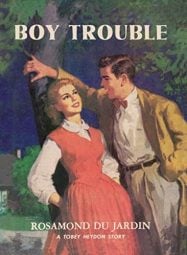
Before there was a designated Young Adult category in publishing, Rosamond du Jardin (1902 – 1963) was known for her novels for the teen reader. Once dismissed as formulaic and dated, her novels are getting a second look, especially in gender studies.
Literary critic Claudia Mills wrote that “they are illuminating as cultural documents, revealing how the values of their decade were transmitted to young readers via the vehicle of story.”
This re-introduction to du Jardin’s books and heroines is excerpted from Girls in Bloom: Coming of Age in the Mid-20th Century Woman’s Novel by Francis Booth, reprinted by permission.
Rosamond du Jardin had written four adult novels and a large number of light short stories for women’s magazines before she started to write books for the teenage market.
She became very prolific and successful, publishing seventeen young adult novels including four Tobey Haydon books, beginning with Practically Seventeen, from 1949 to 1951; two books about Midge Haydon (Tobey’s younger sister) from 1958 to 1961; four books in the Marcy Rhodes series from 1950 to 1957 and four in the Pam and Penny Howard series from 1950 to 1959. All these have recently been republished as physical and electronic books by specialist publisher Image Cascade.
. . . . . . . . . .
Tobey Haydon: Practically Seventeen (1949)
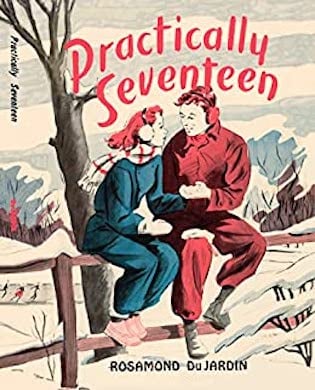
‘My name is Tobey Haydon and I am practically seventeen years old, since my sixteenth birthday was five whole months ago.’
According to Tobey she is, ‘older than my sixteen years in lots of ways, I think.’ This of course is how most sixteen-year-olds feel, including the fictional ones. Tobey (note the gender-ambivalent name) begins by introducing herself and her family, including her sisters and her ‘fairly modern’ parents:
“Ours is quite a large family, as families go nowadays. First there are my mother and father, who are pretty old, in their 40s. Still they are fairly modern in their ideas. My father is tall and thinnish and has a pleasant face with lots of laugh wrinkles. He claims that any man, completely surrounded by females in his own home, would go crazy without a sense of humor and that he has had to develop his in self defense.
Sometimes his wit is a little corny, as is often the case with older people. But none of us mind. He is really sweet, as fathers go. My mother is very well satisfied with him, too. Her only complaint is that his job as a salesman of plumbing supplies takes him away from home on occasional out-of-town trips, during which time she seems to miss him very much indeed.
My mother thinks she is overweight and she is always talking about dieting and losing ten pounds, although compared with the mothers of some of my friends she has a very nice figure.”
Tobey has two older sisters; they are horrid to her; she acts as a kind of Cinderella to them, though the sisters are by no means ugly – as well as a younger sister. Janet, the oldest, is twenty-three with ‘dark red hair and very blue eyes and the kind of figure that rates admiring whistles on street corners,’ though she is married and has a baby known as Toots, ‘a bundle of fiendish energy aged three,’ who is living with the family while Janet’s husband is working away.
Next is her sister Alicia, who is ‘twenty and beautiful, if you care for blondes.’ Alicia, who has just got engaged, is mean and spiteful to Tobey and ‘hasn’t a smidgen of a sense of humor, although how this can be true of one of my father’s daughters is difficult to see.’ Finally, Tobey has:
“… Quite a young sister named Marjorie, but inevitably called Midge. She has a lot more freckles than I, sandy hair that she wears braided in pigtails, and skinny legs. She may improve, though, as she gets older. Right now she is only eight and my father frequently refers to her as The After-thought, this being an example of one of his more corny jokes.”
The recently-engaged Alicia and her fiancé are ‘always kissing. Now I personally, have nothing against this form of amusement, particularly for engaged couples. Still I should think they might want to do something else for a change now and then.’ Tobey does not specify, indeed does not appear to know, what other things engaged couples might do for a change.
Tobey has a boyfriend called Brose who takes her to the movies but does not apparently do very much else with her; on a date with him she puts on lipstick which she has ‘borrowed’ from one of the sisters but she finds it ‘very difficult to maintain any glamour whatever in a family with so many women around, especially sisters.’ They all, including Midge and her mother, mock Tobey’s attempts to look grown-up.
Tobey, like most of the heroines in this genre, is bookish and serious rather than glamorous and flirtatious. Her mother tries to get her to make more of herself: ‘do stop slumping. You have curvature of the spine.’ But still, Tobey has learned some womanly wiles from her older sisters.
‘Brose is really wonderful. I wouldn’t admit this publicly, because it doesn’t pay to let your true opinion of a man get around. Either it goes to his head, or some of your girlfriends decide to try to take him away from you if he’s that terrific. But I am pretty crazy about Brose.’
Tobey certainly does not want to rush into marriage; she has the example of Janet, at twenty-four, who ‘sees life sort of passing her by and her husband’s faraway and she is growing old and older and what does the future hold for her?’ What indeed.
The Tobey and Midge Heydon series
- Practically Seventeen
- Class Ring
- Boy Trouble
- The Real Thing
- Wedding in the Family
- One of the Crowd
. . . . . . . . . .
Marcy Rhodes: Wait for Marcy, 1950
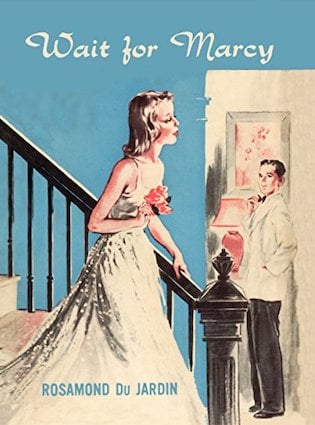
Marcy is a tomboy. But for Christmas her grandmother has bought her – at Marcy’s request – a white net ‘formal,’ a dress to be worn to parties or other formal occasions; another Cinderella reference perhaps (Disney’s film of Cinderella appeared in 1950, too late for du Jardin to have seen it before she wrote these last two novels; Marcia Brown’s popular, illustrated retelling of Perrault’s version of the story was not published until 1955).
Marcy does not really do parties and has never worn the dress. As the novel opens she is sitting:
“… Sprawled comfortably crosswise in a slipcovered chair, deeply engrossed in her favorite magazine. The white shirt she wore had long since been discarded by her father, her blue jeans were deeply cuffed. Floppy moccasins hung from her toes. At fifteen Marcy was dark and slim, with brown hair curled under in a soft bell. Hers were the sort of looks that might easily develop into real loveliness as she grew older.”
Still, despite her tomboyish dress sense, Marcy envies her best friend’s looks; she ‘would gladly have traded high cheek bones, wide dark eyes and golden tan skin for the blonde, blue-eyed prettiness possessed by her closest friend, Liz Kendall.’
Unlike Tobey and Cinderella, Marcy has no sisters, though she does have an older brother, Ken. Older brothers of course are an annoyance, always seeking to embarrass their sister, though Betty Cornell advised that ‘an older brother is about the best social insurance any teen-ager can have.’
Like Tobey’s, Marcy’s mother is ‘an agreeable-looking woman, just verging on plumpness, whose fair hair was only lightly frosted with grey.’ Also like Tobey, she considers that her parents, ‘on the whole, were fairly reasonable,’ though not when her mother starts urging her to go to the school dance, if only so she can wear the formal dress.
“Marcy felt a sick sort of sensation in her tummy. The very first suitable occasion. A dance in the big gym at High, with paper festoons and the lights softened and all the couples, all the girls and their dates, whirling and swaying to just the sort of music that was coming from the radio now. Her lovely white formal would fit into the picture perfectly. But before she could wear it, before she could be a part of the entrancing seen in her mind, someone – who, she wondered if little desperately? – would have to invite her to go with him.
Grow up, why don’t you? That was what Ken had said just now. Marcy was trying, but in some respects it wasn’t easy.”
The Marcy Rhodes series
- Wait for Marcy
- Marcy Catches Up
- A Man for Marcy
- Senior Prom
. . . . . . . . . .
Penny and Pam Howard: Double Date (1951)
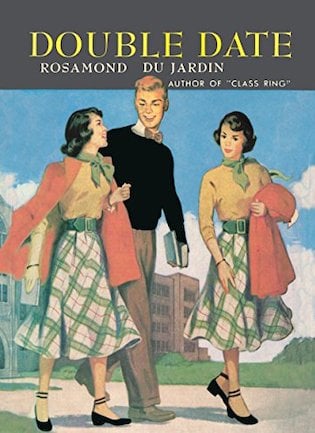
Penny and Pam Howard are twin sisters but have very different personalities; authors of teen novels often use the device of a sister or best friend with an opposite personality to the protagonist; usually she is shy and bookish while the sister/friend is glamorous and popular. The four Penny and Pam novels, though written in the third person, are seen from the perspective of Penny, the introvert.
Pam is outgoing and popular, a Sub-Deb who has read and digested Betty Cornell’s advice. Although they are physically identical, Penny is less gregarious, more shy and reticent. When we see the twins at home, ‘Penny had been intent on her homework, curled on the couch, surrounded by books. Pam had been lying in front of the record-player, dreamily listening to Perry Como.’ Du Jardin gives us access to Penny’s thoughts while Pam is chatting to two boys they have just met:
How could twin sisters, who looked so much alike that most people couldn’t tell them apart, be so unlike inside? She had pondered the question many times before and found no answer. How could Pam chat on so animatedly, so effortlessly, keeping these boys she scarcely knew interested and amused, instilling in them a desire to get better acquainted?
Penny could think of nothing at all to add to Pam’s running comments. Beside her sister she felt leaden and dull and miserably aware of the poor impression she was making. Trudging along with the others, penny spoke only when spoken to directly. Casual, friendly talk eddied about her like a warm current, while she contributed little more than monosyllables. Not that the others seemed to notice. Pam’s voice filled any void that might otherwise have been left by Penny’s silence.
Rosamond du Jardin has presumably chosen to focus on the socially-awkward twin deliberately – she probably assumed, and probably correctly, that teenage girls who read novels like hers rather than Ladies Home Journal columns would themselves be socially awkward and identify more with Penny than Pam, the girl curled up on the couch surrounded by books rather than the girl dreamily listening to crooners. Read in another way of course, Penny is Pam’s alter ego, the girl she wants to be, the girl she – and her readers – aspire to be.
The Penny and Pam Howard series
- Double Date
- Double Feature
- Showboat Summer
- Double Wedding
. . . . . . . . .

Girls in Bloom in full on Issuu
. . . . . . . . .
The decline of the teen novel
Interestingly, the decline of the teen novel coincided with the decline of the crooner. Perry Como (who was old enough to be Penny and Pam’s father) was superseded by the likes of Ladies Home Journal’s columnist Pat Boone, born in 1934, but he was already one of the last of a generation of singers whom teenage girls could listen to with their parents: the same year Boone released his first record, 1954, Elvis Presley was already recording and in 1956 when Presley released Heartbreak Hotel, the era of parent-friendly music was over.
Mothers, and especially fathers, of teenage girls would never again sit round their teenage daughter’s record player singing along with her. Or watch their idols on TV: Elvis’s suggestive gyrations were first seen on the Ed Sullivan show on September 9, 1956, performing Ready Teddy and Hound Dog to the horror of parents all across America.
Elvis was paid $50,000 for three appearances on the show; the first reached 82.6% of the American TV audience. By his third appearance protests from concerned parents ensured that he was filmed only from the waist up. But it was too late; teenage rebellion had begun and teenage girls began to stop wanting to listen to music with their mothers, let alone become them.
Rosamond du Jardin also wrote five novels for adults:
- All is Not Gold. Published by Hurst & Blackett, London, 1935
- Only Love Lasts, 1937 Republished by the Philadelphia Enquirer as a “Gold Seal Novel,” July 27, 1941
- Honorable Estate, Published by Macrae Smith Company, 1943
- Brief Glory, Published by Macrae Smith Company, Philadelphia, 1944
- Tomorrow Will be Fair, Published by Macrae Smith Company, Philadelphia, 1946
. . . . . . . . . .
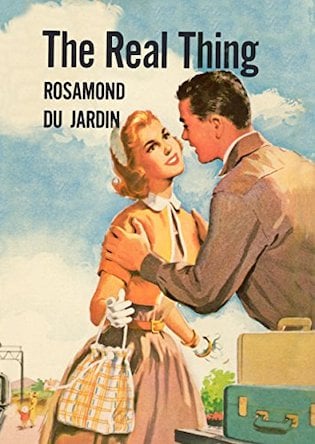
. . . . . . . . . .
Contributed by Francis Booth, the author of several books on twentieth century culture:
Amongst Those Left: The British Experimental Novel 1940-1960 (published by Dalkey Archive); Everybody I Can Think of Ever: Meetings That Made the Avant-Garde; Girls in Bloom: Coming of Age in the Mid-Twentieth Century Woman’s Novel; Text Acts: Twentieth Century Literary Eroticism; High Collars and Monocles: Interwar Novels by Female Couples.and Comrades in Art: Revolutionary Art in America 1926-1938
Francis has also published several novels: The Code 17 series, set in the Swinging London of the 1960s and featuring aristocratic spy Lady Laura Summers; Young adult fantasy series The Watchers; and Young adult fantasy novel Mirror Mirror. Francis lives on the South Coast of England.
What were Rosamond’s four adult novels??
Hi Sandy — Here are her adult novels (there were actually five):
All is Not Gold. Published by Hurst & Blackett, London, 1935
Only Love Lasts, 1937 Republished by the Philadelphia Enquirer as a “Gold Seal Novel,” July 27, 1941
Honorable Estate, Published by Macrae Smith Company, 1943
Brief Glory, Published by Macrae Smith Company, Philadelphia, 1944
Tomorrow Will be Fair, Published by Macrae Smith Company, Philadelphia, 1946